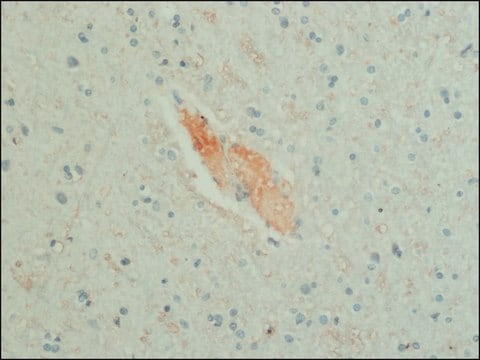G6642
Anti-Glutamate antibody produced in rabbit
whole antiserum
Sinónimos:
Anti-Glutamate Ab, Glutamate Detection Antibody, Rabbit Anti-Glutamate
About This Item
Productos recomendados
origen biológico
rabbit
conjugado
unconjugated
forma del anticuerpo
whole antiserum
tipo de anticuerpo
primary antibodies
clon
polyclonal
contiene
15 mM sodium azide
reactividad de especies
wide range
técnicas
dot blot: 1:15,000
Condiciones de envío
dry ice
temp. de almacenamiento
−20°C
modificación del objetivo postraduccional
unmodified
Categorías relacionadas
Descripción general
The actions of the excitatory amino acids on neurons are mediated by different receptor subtypes. These receptors are coupled to integral ion channels or to a second messenger system which utilizes inositol triphosphate (IP3). L-glutamate and L-aspartate may play an important role in the pathogenesis of certain neurological disorders such as Huntington′s disease, Alzheimer′s disease, epilepsy and brain ischemia. The excitoxic and neurotoxic effects of L-glutamate, leading to extensive neuronal damage, appear to be mediated by the N-methyl-D-aspartate (NMDA) receptor subtype.
Especificidad
Inmunógeno
Aplicación
Immunohistochemistry (1 paper)
Cláusula de descargo de responsabilidad
Not finding the right product?
Try our Herramienta de selección de productos.
Código de clase de almacenamiento
10 - Combustible liquids
Clase de riesgo para el agua (WGK)
WGK 3
Punto de inflamabilidad (°F)
Not applicable
Punto de inflamabilidad (°C)
Not applicable
Certificados de análisis (COA)
Busque Certificados de análisis (COA) introduciendo el número de lote del producto. Los números de lote se encuentran en la etiqueta del producto después de las palabras «Lot» o «Batch»
¿Ya tiene este producto?
Encuentre la documentación para los productos que ha comprado recientemente en la Biblioteca de documentos.
Nuestro equipo de científicos tiene experiencia en todas las áreas de investigación: Ciencias de la vida, Ciencia de los materiales, Síntesis química, Cromatografía, Analítica y muchas otras.
Póngase en contacto con el Servicio técnico








